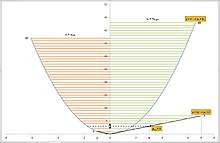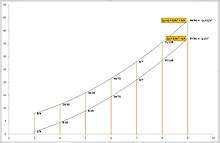Average absolute deviation
The average absolute deviation, or mean absolute deviation (MAD), of a data set is the average of the absolute deviations from a central point. It is a summary statistic of statistical dispersion or variability. In the general form, the central point can be a mean, median, mode, or the result of any other measure of central tendency or any random data point related to the given data set. The absolute values of the differences between the data points and their central tendency are totaled and divided by the number of data points.
Measures of dispersion
Several measures of statistical dispersion are defined in terms of the absolute deviation. The term "average absolute deviation" does not uniquely identify a measure of statistical dispersion, as there are several measures that can be used to measure absolute deviations, and there are several measures of central tendency that can be used as well. Thus, to uniquely identify the absolute deviation it is necessary to specify both the measure of deviation and the measure of central tendency. Unfortunately, the statistical literature has not yet adopted a standard notation, as both the mean absolute deviation around the mean and the median absolute deviation around the median have been denoted by their initials "MAD" in the literature, which may lead to confusion, since in general, they may have values considerably different from each other.
Mean absolute deviation around a central point
The mean absolute deviation of a set {x1, x2, ..., xn} is
The choice of measure of central tendency, , has a marked effect on the value of the mean deviation. For example, for the data set {2, 2, 3, 4, 14}:
| Measure of central tendency | Mean absolute deviation |
|---|---|
| Mean = 5 | |
| Median = 3 | |
| Mode = 2 |
The mean absolute deviation from the median is less than or equal to the mean absolute deviation from the mean. In fact, the mean absolute deviation from the median is always less than or equal to the mean absolute deviation from any other fixed number.
The mean absolute deviation from the mean is less than or equal to the standard deviation; one way of proving this relies on Jensen's inequality.
Proof Jensen's inequality is ,where φ is a convex function, this implies for that: Since both sides are positive, and the square root is a monotonically increasing function in the positive domain:
For a general case of this statement, see Hölder's inequality.
For the normal distribution, the ratio of mean absolute deviation to standard deviation is . Thus if X is a normally distributed random variable with expected value 0 then, see Geary (1935):[1]
In other words, for a normal distribution, mean absolute deviation is about 0.8 times the standard deviation. However, in-sample measurements deliver values of the ratio of mean average deviation / standard deviation for a given Gaussian sample n with the following bounds: , with a bias for small n.[2]
Mean absolute deviation around the mean
The mean absolute deviation (MAD), also referred to as the "mean deviation" or sometimes "average absolute deviation", is the mean of the data's absolute deviations around the data's mean: the average (absolute) distance from the mean. "Average absolute deviation" can refer to either this usage, or to the general form with respect to a specified central point (see above).
MAD has been proposed to be used in place of standard deviation since it corresponds better to real life.[3] Because the MAD is a simpler measure of variability than the standard deviation, it can be useful in school teaching.[4][5]
This method's forecast accuracy is very closely related to the mean squared error (MSE) method which is just the average squared error of the forecasts. Although these methods are very closely related, MAD is more commonly used because it is both easier to compute (avoiding the need for squaring)[6] and easier to understand.[7]
Mean absolute deviation around the median
Mean absolute deviation around the median (MAD median) offers a direct measure of the scale of a random variable around its median
This is the maximum likelihood estimator of the scale parameter of the Laplace distribution. For the normal distribution we have . Since the median minimizes the average absolute distance, we have . By using the general dispersion function, Habib (2011) defined MAD about median as
where the indicator function is
This representation allows for obtaining MAD median correlation coefficients.
Median absolute deviation around a central point
Median absolute deviation around the mean
In principle the mean could be taken as the central point for the median absolute deviation, but more often the median value is taken instead.
Median absolute deviation around the median
The median absolute deviation (also MAD) is the median of the absolute deviation from the median. It is a robust estimator of dispersion.
For the example {2, 2, 3, 4, 14}: 3 is the median, so the absolute deviations from the median are {1, 1, 0, 1, 11} (reordered as {0, 1, 1, 1, 11}) with a median of 1, in this case unaffected by the value of the outlier 14, so the median absolute deviation (also called MAD) is 1.
Maximum absolute deviation
The maximum absolute deviation around an arbitrary point is the maximum of the absolute deviations of a sample from that point. While not strictly a measure of central tendency, the maximum absolute deviation can be found using the formula for the average absolute deviation as above with , where is the sample maximum.
Minimization
The measures of statistical dispersion derived from absolute deviation characterize various measures of central tendency as minimizing dispersion: The median is the measure of central tendency most associated with the absolute deviation. Some location parameters can be compared as follows:
- L2 norm statistics: the mean minimizes the mean squared error
- L1 norm statistics: the median minimizes average absolute deviation,
- L∞ norm statistics: the mid-range minimizes the maximum absolute deviation
- trimmed L∞ norm statistics: for example, the midhinge (average of first and third quartiles) which minimizes the median absolute deviation of the whole distribution, also minimizes the maximum absolute deviation of the distribution after the top and bottom 25% have been trimmed off.
Estimation

The mean absolute deviation of a sample is a biased estimator of the mean absolute deviation of the population. In order for the absolute deviation to be an unbiased estimator, the expected value (average) of all the sample absolute deviations must equal the population absolute deviation. However, it does not. For the population 1,2,3 both the population absolute deviation about the median and the population absolute deviation about the mean are 2/3. The average of all the sample absolute deviations about the mean of size 3 that can be drawn from the population is 44/81, while the average of all the sample absolute deviations about the median is 4/9. Therefore, the absolute deviation is a biased estimator.
However, this argument is based on the notion of mean-unbiasedness. Each measure of location has its own form of unbiasedness (see entry on biased estimator). The relevant form of unbiasedness here is median unbiasedness.

See also
- Deviation (statistics)
- Mean absolute error

- Errors and residuals in statistics
- Least absolute deviations
- Loss function
- Mean absolute percentage error
- Mean difference
- Mean squared error
- Median absolute deviation
- Squared deviations
References
- Geary, R. C. (1935). The ratio of the mean deviation to the standard deviation as a test of normality. Biometrika, 27(3/4), 310–332.
- See also Geary's 1936 and 1946 papers: Geary, R. C. (1936). Moments of the ratio of the mean deviation to the standard deviation for normal samples. Biometrika, 28(3/4), 295–307 and Geary, R. C. (1947). Testing for normality. Biometrika, 34(3/4), 209–242.
- "Archived copy". Archived from the original on 2014-01-16. Retrieved 2014-01-16.CS1 maint: archived copy as title (link) CS1 maint: BOT: original-url status unknown (link)
- Kader, Gary (March 1999). "Means and MADS". Mathematics Teaching in the Middle School. 4 (6): 398–403. Archived from the original on 2013-05-18. Retrieved 20 February 2013.
- Franklin, Christine, Gary Kader, Denise Mewborn, Jerry Moreno, Roxy Peck, Mike Perry, and Richard Scheaffer (2007). Guidelines for Assessment and Instruction in Statistics Education (PDF). American Statistical Association. ISBN 978-0-9791747-1-1. Archived (PDF) from the original on 2013-03-07. Retrieved 2013-02-20.
- Nahmias, Steven; Olsen, Tava Lennon (2015), Production and Operations Analysis (7th ed.), Waveland Press, p. 62, ISBN 9781478628248,
MAD is often the preferred method of measuring the forecast error because it does not require squaring.
- Stadtler, Hartmut; Kilger, Christoph; Meyr, Herbert, eds. (2014), Supply Chain Management and Advanced Planning: Concepts, Models, Software, and Case Studies, Springer Texts in Business and Economics (5th ed.), Springer, p. 143, ISBN 9783642553097,
the meaning of the MAD is easier to interpret
.